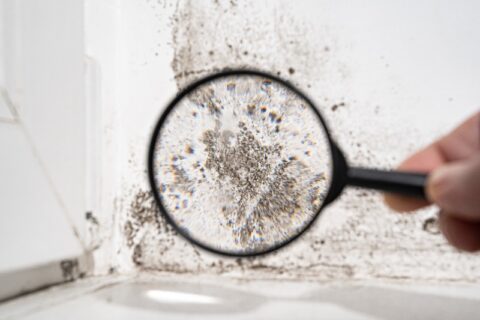Mold vs. Mildew

Have you ever wondered what the difference is between mold and mildew? They’re both types of fungus, and they’re both bad news for your home. But these different terms exist for a good reason. Let’s take a look at the characteristics of mold and mildew, and how they differ.
What Is Fungus?
It may be helpful to first establish what fungus is. Fungi are members of a kingdom of life separate from the plant, animal and bacteria kingdoms. This includes all the lovely mushrooms we’re all familiar with, as well as microorganisms such as yeast, mold and mildew. Unlike animals, fungi have cell walls. But unlike plants, fungi have a polymer called chitin in their cell walls, and they do not photosynthesize. Instead, they survive by breaking down and absorbing organic matter, as animals do.
What Is Mold?
Mold is a collection of fungi growing in the form of multicellular filaments called hyphae. (In contrast, yeasts are single-celled growths.) Each network of these hyphae (called a mycelium) is considered one mold organism. Since these hyphae are translucent, molds often appear fuzzy, but wetter varieties can appear slimy. They also develop reproductive spores in a variety of colors — blue, green, orange, red, black, etc.
What Is Mildew?
Mildew has so much in common with mold that it has been considered to be a kind of mold, but it does have its unique characteristics. They both consist of hyphae. But while mold tends to grow below surfaces, mildew tends to grow on the surface. For this reason it’s easier to get rid of.
Mildew also appears powdery, as opposed to the fuzzy or slimy appearances of mold formations. In contrast to the diverse color varieties of mold, mildew tends to be just white. (The red “mildew” often found on bathroom surfaces such as shower curtains is actually not mold or mildew but one of their single-celled yeast cousins.)
Another distinction between mold and mildew is odor. Mildew often gives off a faint musty smell similar to old wet socks. Since mold tends to be larger, it also tends to have a stronger smell. This is also because mold creates gaseous chemicals known as microbial volatile organic compounds (MVOCs) as it grows. The presence of MVOCs are a good indication to experts of a mold infestation.
Pacific Flood Restoration is a mold remediation company in San Diego. We can help you prevent mold and mildew from growing in your home and fix whatever damage they may have caused in your home. We have a reputation for integrity and high-quality services. Give us a call at 832-294-5462 or contact us online if you find signs of water damage in your home.


